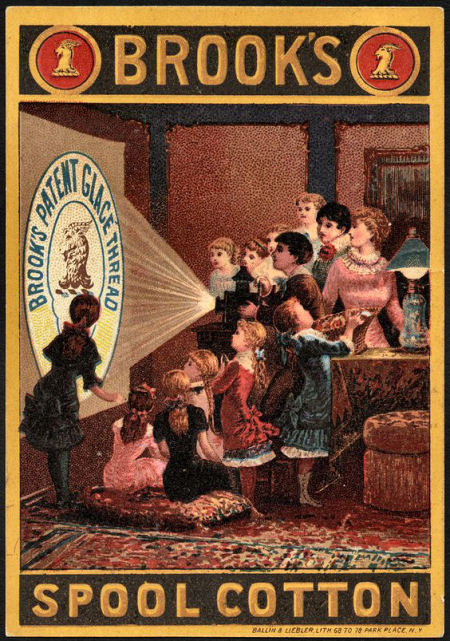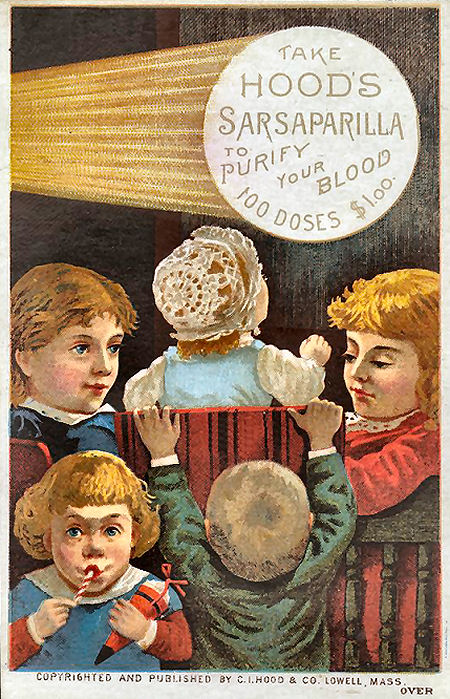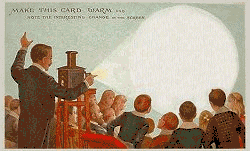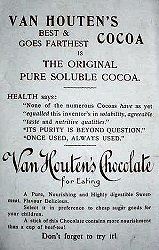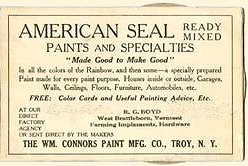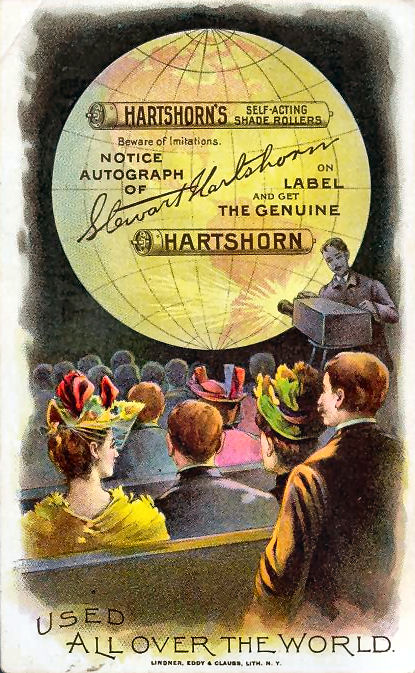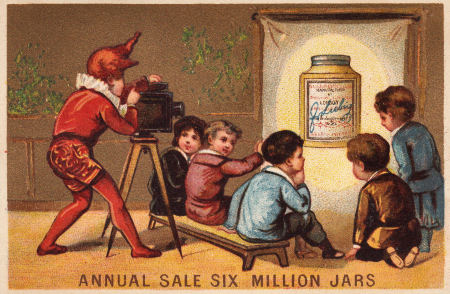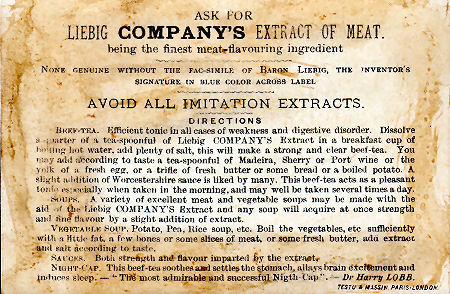|
Trade cards and the magic
lantern part 1 |
|
|
|
In
1846 the American inventor Elias Howe patented a sewing machine using
an eye pointed needle and an oscillating shuttle. Isaac Merrit Singer laid
the groundwork for the mass production of this labour saving tool. Soon the
sewing machine became an essential household appliance in many Victorian
homes.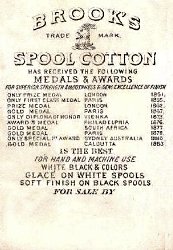 A lot of of lovely images on trade cards are devoted to the sewing machine and sewing threads.
This card is about 11,5 x 7.5 cm (4.5" x 3") and shows
a homey scene with a group of children and a boy projecting Brook's goat head
trademark on the
wall. The card is printed in rich colours with orange and dark hues, thus
creating a striking exception to the usual effects created by the lighter
inks often used in trade card images. A lot of of lovely images on trade cards are devoted to the sewing machine and sewing threads.
This card is about 11,5 x 7.5 cm (4.5" x 3") and shows
a homey scene with a group of children and a boy projecting Brook's goat head
trademark on the
wall. The card is printed in rich colours with orange and dark hues, thus
creating a striking exception to the usual effects created by the lighter
inks often used in trade card images.On the reverse side a list of the medals and awards won by Brook's, Size: 11 cm x 8 cm (4 3/8" x 3 1/8"). |
||
It's
really enjoyable to see all the ways that a spool of thread was
incorporated into the image on the trade card.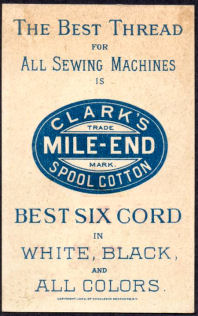 This card advertising Clark's Thread shows
cats dressed as people watching a magic lantern lecture. One may wonder what
excites them most, the running mice or the superior quality of the thread.
The image appears to be borrowed from the work of the British illustrator
Louis Wain, whose book, magazine and postcard images of cats are considered
highly collectible. This card advertising Clark's Thread shows
cats dressed as people watching a magic lantern lecture. One may wonder what
excites them most, the running mice or the superior quality of the thread.
The image appears to be borrowed from the work of the British illustrator
Louis Wain, whose book, magazine and postcard images of cats are considered
highly collectible.This card is an example of a custom design card. These cards mostly picture the product being advertised at the front. The company did not share the design with other firms. Size: 11 cm x 8 cm (4 3/8" x 3 1/8"). |
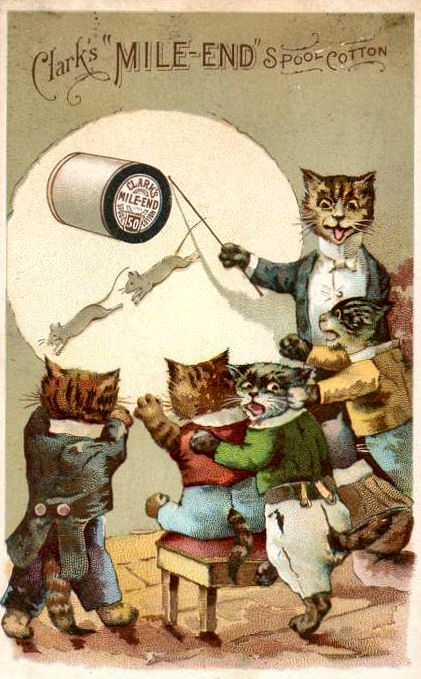
|
||
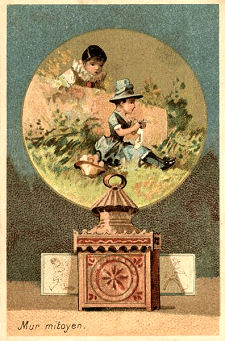
|
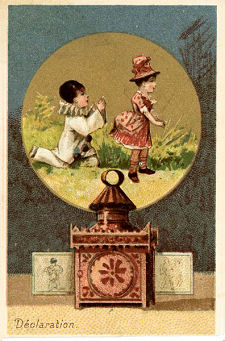
|
Series
of six cards in chromolithography depicting a magic lantern showing Pierrot
and his lovely girl friend Columbine in a country landscape. These cards are examples of stock cards, which could be applied to any product. The backs are blank and could be printed by the advertiser. Usually there was a blank area on the front for the customer to print as well.  Size:
approx.10.5 x 7 cm (4" x 2 3/4"). Printer is the well-known Champenois & Co. Paris,
who printed so many cards for Liebig, Au Bon Marché and others. Perhaps
Lapierre's Lanterne Carrée served as a model for the magic lantern on
these beautiful cards. Size:
approx.10.5 x 7 cm (4" x 2 3/4"). Printer is the well-known Champenois & Co. Paris,
who printed so many cards for Liebig, Au Bon Marché and others. Perhaps
Lapierre's Lanterne Carrée served as a model for the magic lantern on
these beautiful cards.
|
|
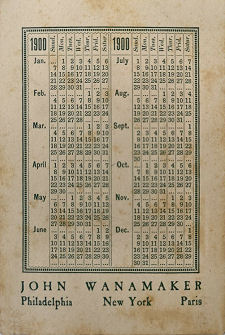 |
1. Pierrot loves Colombine, the
pleasant girl next door that hides herself behind the partition wall
(Mur Mitoyen). 2. Pierrot adores Colombine and declares her his love (Declaration). 3. Colombine goes to a meadow where she encounters her sentimental little friend again (Premier Rendez-vous). 4. Pierrot tries to conquer Colombines heart and gives her flowers as a first present (Premier Cadeau). 5. When anneer Harlequin arrives Colombines heart starts to doubt. There is an altercation (Entrevue Troublée). 6. Colombine is tempted by Harlequin's farces and Harlequin punishes the poor Pierrot (Correction Méritée). |
||
| The 1900 calendar is printed on the back of this series of cards, making it easy to determine the age of the cards. | |||
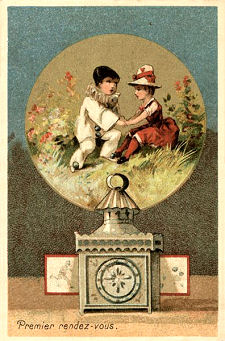 |
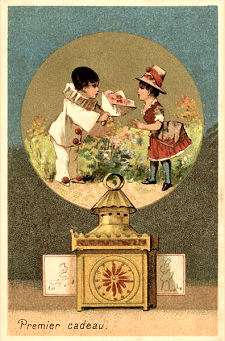 |
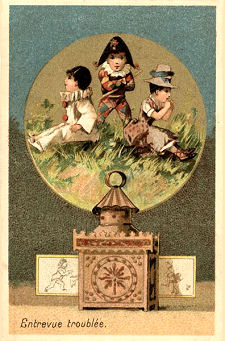 |
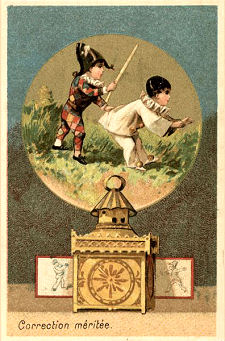 |
|
Five French trade cards picturing scenes from one of Florian's fables, 'Le Singe qui montre la Lanterne Magique' (The monkey that is giving a magic lantern show). 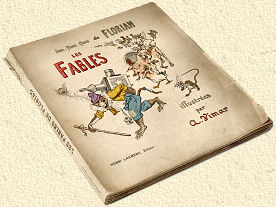 |
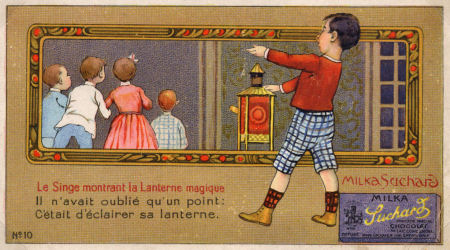 |
||
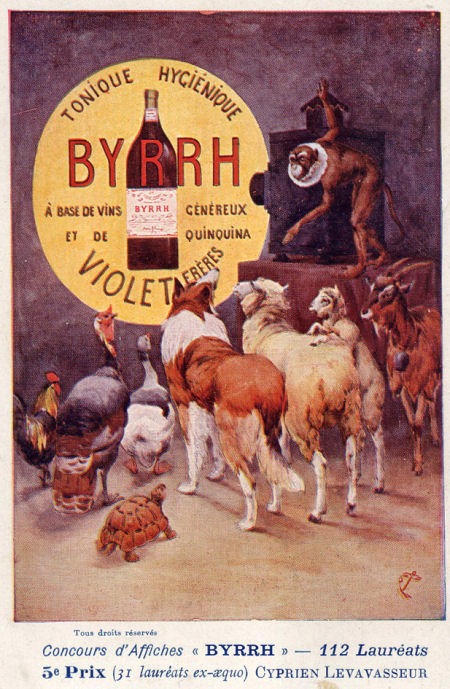 |
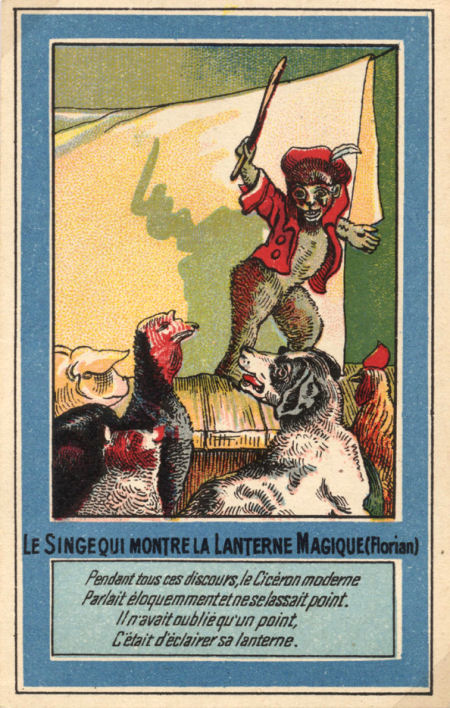 |
||
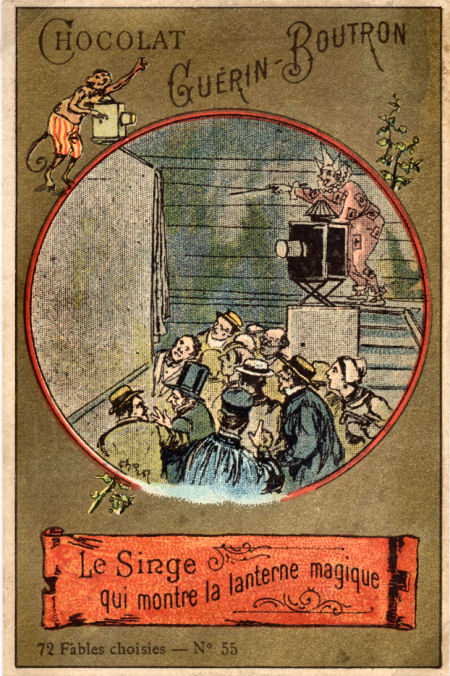 |
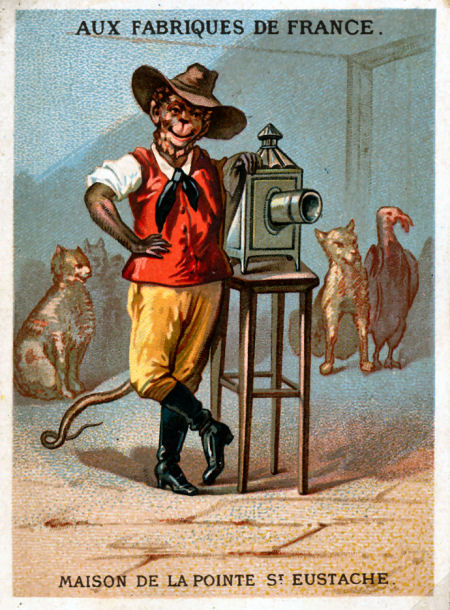
|
||
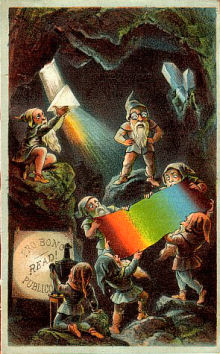
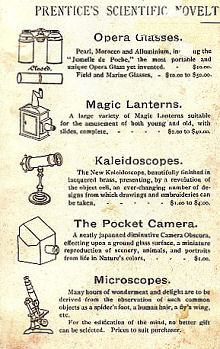 |
The
19th century was a time of invention and innovation. New products were
introduced almost daily, with the cards conscientiously reflecting the
developments. This nice Victorian trade card shows some gnomes using a prism to create a rainbow effect while another gnome shows a slide using a magic lantern. On the back is an ad for Prentice Scientific Novelties with line drawings and prices of some optical devices, including a drawing of the magic lantern used on the other side. |
||
Hood's
Sarsaparilla.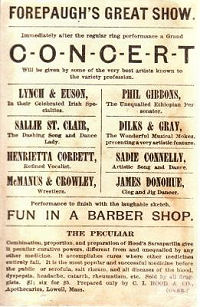 Nice image with circus advertising on reverse. Size approx
8 x 12 cm (3.1" x 4.75"). A magic lantern projects the text 'Take
Hood's Sarsaparilla; purify your blood' above the heads of the audience which is
paying but little attention to the message. Nice image with circus advertising on reverse. Size approx
8 x 12 cm (3.1" x 4.75"). A magic lantern projects the text 'Take
Hood's Sarsaparilla; purify your blood' above the heads of the audience which is
paying but little attention to the message.Almost every type of product imaginable was advertised by trade cards, however medicines are among the most promoted. Many trade cards have stains on the back from the glue that was used to hold the cards in the scrapbooks. |
|
||
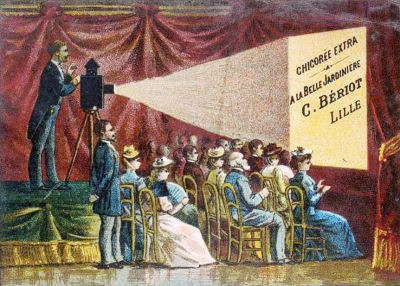 |
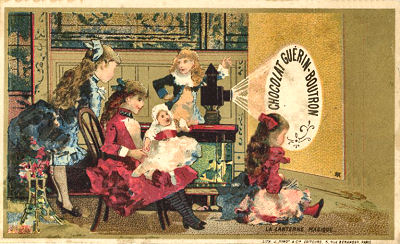 |
||
| Trade card
for Chicoree Extra a la Belle Jardiniere C. Bériot, Lille. |
Trade card for Chocolat Guérin-Boutron. Published by: Vallet, Minot & Cie, Imprimeurs, éditeurs, 5 Rue Beranger, Paris. Sizes c. 12 x 8 cm. |
||
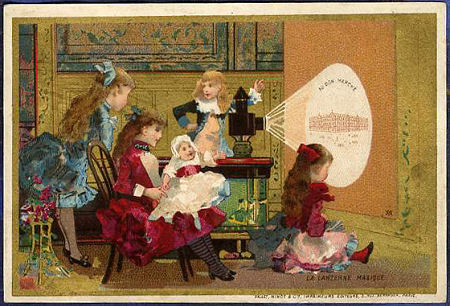 |
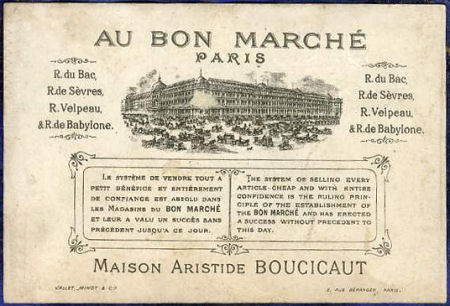 |
||
|
A trade card with almost the same
image as the card above, but now with an advertisement for the old Parisian department store 'Au Bon Marché', c. 1880. The
projected image on the wall shows the impressive building and the text 'Au Bon Marché'.
Text below the most right girl 'La Lanterne Magique'. Published by
Vallet, Minot & Cie, Imprimeurs Editeurs, 5 Rue Béranger, Paris. Measures c.
4.75" x 3.25" (12 x 8 cm). |
|||
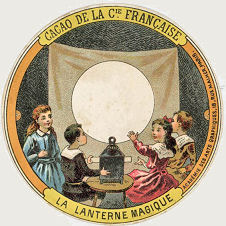
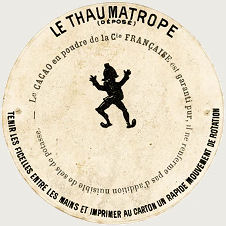 |
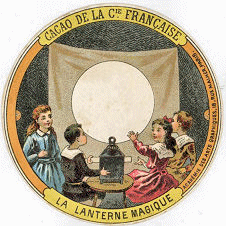 |
Cacao de la Cie Francaise. A very special trade card produced as a thaumatrope. The card must be rotated rapidly between your hands by means of two small strings to see the effect. |
|
|
This nice French trade card
portrays a small group of children enjoying a magic lantern show. This
litho card has an advertisement for Au Bon Pasteur, Habillements pour hommes
et enfants (Clothes for men and children), Rue de la Tonnelarie 18, Chartres,
on both sides. The card measures 4.75 x 3 1/8 inch (ca
12 x 8 cm). It is numbered 502 on the left bottom hand face corner. |
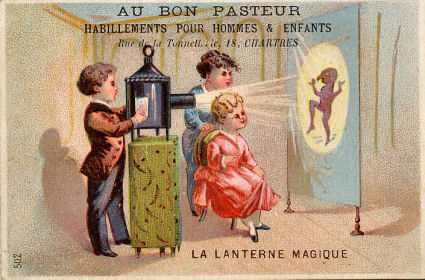 |
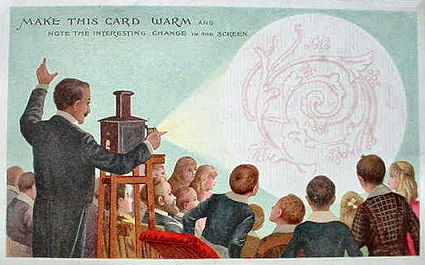 |
|
|
Very special trade card issued
by the Dutch chocolate and cocoa manufacturer Van Houten. Inscription: 'MAKE THIS CARD WARM and note the interesting change on the screen'. |
|
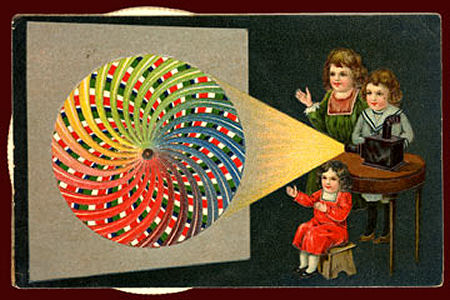
|
This great Victorian trade card has a lovely graphic on the front
showing three little children playing with their magic lantern. The
projected
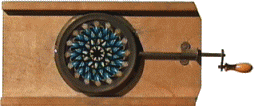 image
on the screen shows an almost real chromatrope with amazing light effects. A
printed cardboard disc is set between the front and back panels of the card.
This disc pokes out at the sides of the card and can be operated by turning. When the disc
is rotated the
coloured lines printed on the disc run contrary
to a die-cut set of coloured lines attached to the front of the card. This
mimics a realistic chromatrope effect. image
on the screen shows an almost real chromatrope with amazing light effects. A
printed cardboard disc is set between the front and back panels of the card.
This disc pokes out at the sides of the card and can be operated by turning. When the disc
is rotated the
coloured lines printed on the disc run contrary
to a die-cut set of coloured lines attached to the front of the card. This
mimics a realistic chromatrope effect.
Size of the card: 9 x 14 cm (3 1/2" by 5 1/2"). More information on chromatropes you can find here. |
|
Another wonderful mechanical trade card using a revolving disc between the panels of the card. At the back a recommendation for COTTOLENE, an American shortening made from cotton oil: "Use Cottolene for Shortening, Pastry, Cake, Rolls and Bread" and "Use Cottolene for all Frying". 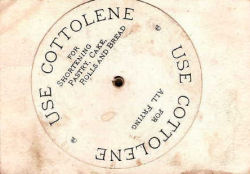 Turning the disc that pokes out at one side of
the card, presents successively six images on the 'screen': a fish ready to fry, a man eating a pie, a
lady about to eat cake, a cartoon of a lard can as a king, a child eating a
pastry and a lady eating cake. The accompanying texts are respectively: (COTTOLENE) "is the best to fry fish in",
"makes delicious crisp pastry", "is conducive to health", "is superior to lard.",
"is safe for children" and "dyspeptics can eat cake made with it". Turning the disc that pokes out at one side of
the card, presents successively six images on the 'screen': a fish ready to fry, a man eating a pie, a
lady about to eat cake, a cartoon of a lard can as a king, a child eating a
pastry and a lady eating cake. The accompanying texts are respectively: (COTTOLENE) "is the best to fry fish in",
"makes delicious crisp pastry", "is conducive to health", "is superior to lard.",
"is safe for children" and "dyspeptics can eat cake made with it". |
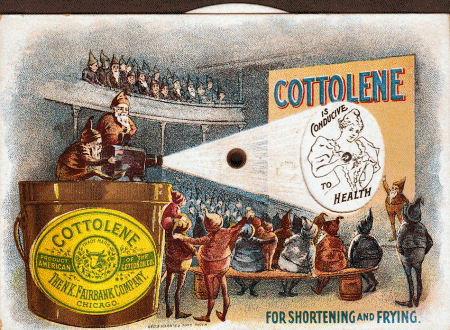 Printed by cigar label lithographer Geo. S. Harris & Sons, Philadelphia, about 1890. Size 12.6 x 9 cm. |
|
|
Thanks to Dave Cheadle for sending me the
COTTOLENE and HARTSHORN cards. |
Trade card
from Harthorn's self acting shade rollers, used to darken a room (Beware of imitations). Reverse
is a text ad: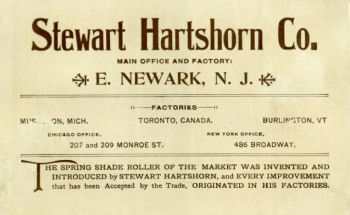 Printer Lindner, Eddy & Clauss, Lith. N.Y.,
about 1890. Size: 8.5 x 13.5 cm. |
|
|
|
|
|
This English Liebig trade card is part of a 12-card set,
Sanguinetti #75,
issued in the 1870's, for Liebig Company's extract of meat (avoid all
imitation extracts). Size: 7 x 10.5 cm (2 3/4" x 4 1/8"). Printer is Testu & Massin, Paris-London. |
|





 |
|
|
Another advertisement for Liebig
Company's extract of meat.
One of a series of six
cards with the subject Le Pigeon-Voyageur (the carrier-pigeon). The
six cards show how the pigeons are released (La Station de Départ),
and finaly how the message is enlarged by a magic lantern (L’agrandissement
des dépêches). |
 |
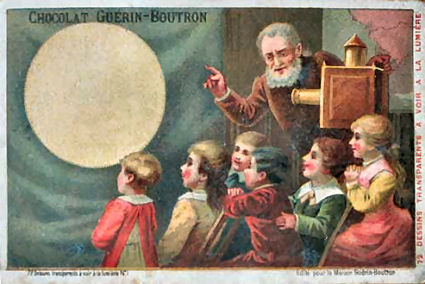
|
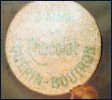 This
French trade card is printed for CHOCOLAT GUERIN-BOUTRON and has on the
right side the text: 'Dessins transparants a voir à la lumière' ('The
transparent image must be viewed up to the light'). When you follow this
instruction a text appears into the circle: 'J'aime Le Chocolat Guerin - Boutron'. This
French trade card is printed for CHOCOLAT GUERIN-BOUTRON and has on the
right side the text: 'Dessins transparants a voir à la lumière' ('The
transparent image must be viewed up to the light'). When you follow this
instruction a text appears into the circle: 'J'aime Le Chocolat Guerin - Boutron'. |
| Onder welken vorm zij ook voorkomen, de LIEBIG
PRODUKTEN zijn het resultaat van een beproefde kookkunst
ondervinding. KLEINE STRAATAMBACHTEN VAN VOORHEEN. 1. 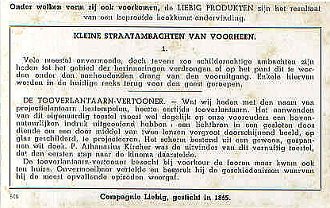
Vele, meestal onvermoede, doch tevens zoo schilderachtige
ambachten zijn
heden tot het gebied der herinneringen verdrongen of op het punt dit te worden onder den aanhoudenden drang van den
vooruitgang. Enkele hiervan worden in de huidige reeks terug voor den geest geroepen. |
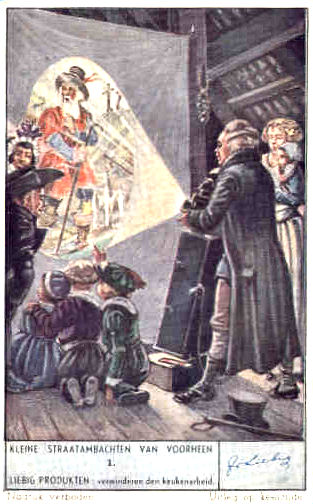 Dutch Liebig trade card showing a man in 19th century clothing presenting a magic lantern show for a small group of adults and children. The back of the card has a text in Dutch, on DE TOOVERLANTAARN VERTOONER (The Lanternist, the Magic Lantern Man). |
|
On the front we read: KLEINE STRAATAMBACHTEN VAN VOORHEEN. 1. LIEBIG PRODUKTEN verminderen den keukenarbeid. Nadruk verboden. Uitleg op keerzijde (Old street crafts, part 1. Liebig Products decrease kitchen work. All rights reserved. Explanation on back). Sizes: 2 ¾ inches by 4 3/8 inches (7 x 10.5 cm). |
|
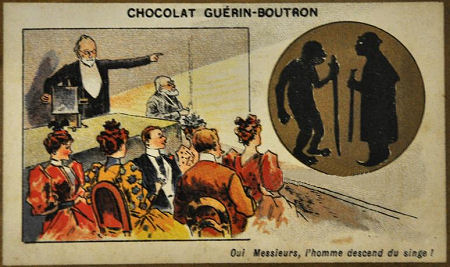 |
The
title on the front of this card says: 'Oui Messieurs, L'Homme descend du
Singe' (Yes ladies and gentlemen, men descend from monkeys). It advertises
the company of 'Chocolat Guérin-Boutron'. The card measures 4 1/4" x 2 1/2" (11 x 6.5 cm). |
|
More trade cards.............. |
|
|
|
|
| |
©1997-2021 'de Luikerwaal' All rights reserved. Last update: 24-11-2021. |
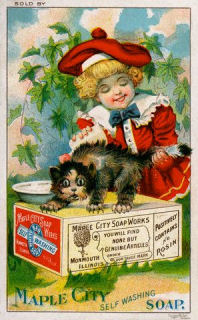 Victorian
trade cards are19th-century promotional ads for various products and services.
Most of them are a little smaller than a post card, about 7.5 x 13 cm (3" x 5"). Manufacturers gave millions of
those colourful trade cards away as advertising souvenirs at all of the major exhibitions and many people
fell into the habit of collecting the cards, pasting them into large scrap book albums. At the local food store many of
these cards came packaged in tins of coffee or tea, or were handed out to the customers for free.
The 1867 Centennial Exhibition held in Philadelphia marked a important part in the history of trade card
collecting. Lithography had just been introduced and the appearance of the now beautifully coloured cards set off a
collecting craze. Trade Cards all but disappeared from the scene by the end of the 1904 World's Fair.
They were eventually replaced by full-colour magazine ads and young people
saw trade cards as too old fashioned to collect.
Victorian
trade cards are19th-century promotional ads for various products and services.
Most of them are a little smaller than a post card, about 7.5 x 13 cm (3" x 5"). Manufacturers gave millions of
those colourful trade cards away as advertising souvenirs at all of the major exhibitions and many people
fell into the habit of collecting the cards, pasting them into large scrap book albums. At the local food store many of
these cards came packaged in tins of coffee or tea, or were handed out to the customers for free.
The 1867 Centennial Exhibition held in Philadelphia marked a important part in the history of trade card
collecting. Lithography had just been introduced and the appearance of the now beautifully coloured cards set off a
collecting craze. Trade Cards all but disappeared from the scene by the end of the 1904 World's Fair.
They were eventually replaced by full-colour magazine ads and young people
saw trade cards as too old fashioned to collect.